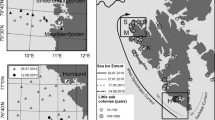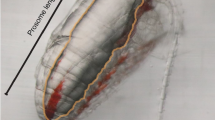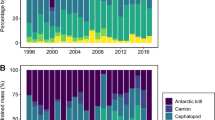Abstract
Loch Ruthven holds the largest British population of the rare water-bird Podiceps auritus, the Slavonian or horned grebe. The breeding success of this bird has fluctuated annually since records began in 1970. To investigate whether these trends are linked to the abundance of chironomid midges, which are an important food-source for the grebe chicks, we analysed a sediment core from the lake, which was sliced at 2.5-mm intervals and provided near-annual sampling resolution. We also analysed diatoms and algal pigments in the lake sediments and inferred changes in total phosphorus from the diatom assemblage to determine whether changes in lake productivity have influenced the abundance of chironomids. Trends in grebe productivity, chironomid abundance and algal assemblages were compared against climate data to determine whether climate, specifically, the North Atlantic Oscillation, was the ultimate driver of the trends we recorded. Our results show that grebe breeding success is positively correlated with chironomid abundance and chironomid abundance is positively correlated with diatom-inferred total phosphorus. Lake productivity and chironomid abundance began to rise early in the twentieth century and continued to rise on a steeper trajectory from the mid-twentieth century to the present. Since the mid-1960s, chironomid abundance began to fluctuate erratically and since 1970 was in phase with grebe productivity, with the grebe trends most plausibly lagging by 1 year. These trends appear to correlate with inter-annual fluctuations in diatom-inferred total phosphorus. No correlation was found between grebe productivity or chironomid abundance and climate variables, suggesting that the size of the chironomid population and breeding success of Podiceps auritus at Loch Ruthven is resource-linked.










Similar content being viewed by others
References
Anderson NJ (1986) Diatom biostratigraphy and comparative core correlation within a small lake basin. Hydrobiologia 143:105–112
Anderson NJ, Rippey B, Gibson CE (1993) A comparison of sedimentary and diatom inferred phosphorous profiles: implications for defining pre-disturbance nutrient conditions. Hydrobiologia 253:357–366
Appleby PG (2001) Chronostratigraphic techniques in recent sediments. In: Last WM, Smol JP (eds) Tracking environmental change using lake sediments volume 1: basin analysis, coring, and chronological techniques. Kluwer Academic Publishers, Dordrecht, pp 171–203
Appleby PG, Oldfield F (1978) The calculation of 210Pb dates assuming a constant rate of supply of unsupported 210Pb to the sediment. Catena 5:1–8
Appleby PG, Nolan PJ, Gifford DW, Godfrey MJ, Oldfield F, Anderson NJ, Battarbee RW (1986) 210Pb dating by low background gamma counting. Hydrobiologia 141:21–27
Appleby PG, Richardson N, Nolan PJ (1991) 241Am dating of lake sediments. Hydrobiologia 214:35–42
Appleby PG, Richardson N, Nolan PJ (1992) Self-absorption corrections for well-type germanium detectors. Nucl Inst Methods B 71:228–233
Battarbee RW, Kneen MJ (1982) The use of electronically counted microspheres in absolute diatom analysis. Limnol Oceanogr 27:184–188
Battarbee RW, Jones VJ, Flower RJ, Cameron NG, Bennion H (2001a) Diatoms. In: Smol JP, Birks HJB, Last WM (eds) Tracking environmental change using lake sediments, vol 3. Kluwer Academic Publishers, Dordrecht, pp 155–202
Battarbee RW, Cameron NG, Golding P, Brooks SJ, Switsur R, Harkness D, Appleby P, Oldfield F, Thompson R, Montieth DT (2001b) Evidence for Holocene climate variability from the sediments of a Scottish remote mountain lake. J Quat Sci 16:339–346
Bennion H, Fluin J, Simpson GL (2004) Assessing eutrophication and reference conditions for Scottish freshwater lochs using subfossil diatoms. J Appl Ecol 41:124–138
Bennion H, Johnes P, Phillips G, Haworth E (2005) A comparison of diatom phosphorous transfer functions and export coefficient models as a tool for reconstructing lake nutrient histories. Freshw Biol 50:1651–1670
Bennion H, Clarke G, Goldsmith B, Battarbee RW (2010) Diatom analysis of three Norwegian cores. Environmental Change Research Centre, Research Report No. 142. Report to the Norwegian Institute for Water Research Project Number O-28428
Björnsson H, Jónsson T (2004) Climate and climatic variability at Lake Myvatn. Aquat Ecol 38:129–144
Brooks SJ, Langdon PG, Heiri O (2007) The identification and use of Palaearctic Chironomidae larvae in palaeoecology. Quaternary Research Association Technical Guide no. 10, Pontypool, p 276
Catchpole EA, Morgan BJT, Coulson TN, Freeman SN, Albon DD (2000) Factors influencing Soay sheep survival. Appl Stat 49:453–472
Cramp S, Simmons KEL (1977) The birds of the western palearctic, vol 1. Oxford University Press, Oxford
Cuddington K, Leavitt PR (1999) An individual-based model of pigment flux in lakes: implications for organic biogeochemistry and paleoecology. Can J Fish Aquat Sci 56:1964–1977
Dalton C, Birks HJB, Brooks SJ, Cameron NG, Evershed RP, Peglar SM, Scott JA, Thompson R (2005) A multiproxy study of lake-development in response to catchment changes during the Holocene at Lochnagar, north-east Scotland. Palaeogeogr Palaeoclimatol Palaeoecol 221:175–201
Durance I, Ormerod SJ (2007) Climate change effects on upland stream macroinvertebrates over a 25-year period. Glob Change Biol 13:942–957
Einarsson A, Gardarsson A (2004) Moulting diving ducks and their food supply. Aquat Ecol 38:297–307
Einarsson A, Gardarsson A, Gíslason GM, Ives AR (2002) Consumer-resource interactions and cyclic population dynamics of Tanytarsus gracilentus (Diptera: Chironomidae). J Anim Ecol 71:832–845
Einarsson A, Stefánsdottir G, Jóhannesson H, Ólafsson JS, Gíslason GM, Wakana I, Gudbergsson G, Gardarsson A (2004) The ecology of Lake Myvatn and the River Laxá: variation in space and time. Aquat Ecol 38:317–348
Fjeldså J (1973) Antagonistic and heterosexual behaviour of the Horned Grebe, Podiceps auritus. Sterna 12:161–217
Fromentin J-M, Planque B (1996) Calanus and environment in the eastern North Atlantic. II. Influence of the North Atlantic Oscillation on C. finmarchicus and C. heligolandicus. Mar Ecol Prog Ser 134:111–118
Gardarsson A, Einarsson A (1994) Responses of breeding duck populations to changes in food supply. Hydrobiologia 279(280):15–27
Gardarsson A, Einarsson A (1997) Numbers and production of Eurasian wigeon in relation to conditions in a breeding area, Lake Myvatn, Iceland. J Anim Ecol 66:439–451
George DG (2000) The impact of regional-scale changes in the weather on the long-term dynamics of Eudiaptomus and Daphnia in Esthwaite Water, Cumbria. Freshw Biol 45:111–121
Ives AR, Einarsson A, Jansen VAA, Gardarsson A (2008) High-amplitude fluctuations and alternative dynamical states of midges in Lake Myvatn. Nature 452:84–87
Jackson DB (2005) Environmental correlates of lake occupancy and chick survival of Black-throated Divers Gavia arctica in Scotland. Bird Study 52:225–236
Jones VJ (2007) Diatom introduction. In: Elias SA (ed) Encyclopedia of quaternary science. Elsevier, Oxford, pp 476–484
Juggins S (2007) C2 version 1.5: software for ecological and palaeoecological data analysis and visualisation [program]. University of Newcastle, Newcastle upon Tyne
Krammer K, Lange-Bertalot H (1986–1991) Süßwaßerflora von Mitteleuropa, Bacillariophycae. Gustav Fischer Verlag, Stuttgard
McGhie HA (1994) Discovery of the first clutch of Slavonian grebe eggs in a museum collection. Scott Birds 17:166–167
McGowan S (2007) Pigment studies. In: Elias SA (ed) Encyclopedia of quaternary science. Elsevier, Oxford, pp 2066–2081
Ólafsson J (1999) Connections between oceanic conditions off N-Iceland, Lake Myvatn temperature, regional wind direction variability and the North Atlantic Oscillation. Rit Fiskid 16:41–57
Parsons LS, Lear WH (2001) Climate variability and marine ecosystem impacts: a north Atlantic perspective. Prog Oceanogr 49:167–188
Perkins AJ, Hancock MH, Butcher N, Summers RW (2005) Use of time-lapse video cameras to determine causes of nest failure of Slavonian grebes Podiceps auritus. Bird Study 52:159–165
Post E, Stenseth N, Lanvatn R, Fromentin J-M (1997) Global climate change and phenotypic variation amongst red deer cohorts. Proc R Soc Biol Sci Ser B 264:1317–1324
Renberg I (1991) The HON-Kajak sediment corer. J Paleolimnol 6:161–170
Romero-Viana L, Keely BJ, Camacho A, Vicente E, Miracle MR (2010) Primary production in Lake La Cruz (Spain) over the last four centuries: reconstruction based on sedimentary signal of photosynthetic pigments. J Palaeolimnol 43:771–786
Sharrock JTR (1976) The atlas of breeding birds in Britain and Ireland. Poyser
Summers RW, Mavor RA (1995) Occupation pattern of lochs by Slavonian grebes in Scotland. Scott Birds 18:65–70
Summers RW, Mavar RA, Hancock MH (2009) Correlates of breeding success of Slavonian grebes in Scotland. Waterbirds 32:265–275
ter Braak CJF, van Dam H (1989) Inferring pH from diatoms: a comparison of old and new calibration methods. Hydrobiologia 178:209–223
van Hardenbroek M, Heiri O, Wilhelm MF, Lotter AF (2011) How representative are subfossil assemblages of Chironomidae and common benthic invertebrates for the living fauna of Lake De Waay, the Netherlands? Aquat Sci 73:247–259
Westgarth-Smith AR, Leroy SAG, Collins PEF, Harrington R (2007) Temporal variations in English populations of a forest pest, the green spruce aphid (Elatobium abietinum), associated with the North Atlantic Oscillation and global warming. Quat Int 173–174:153–160
Acknowledgments
Julieta Massaferro and John Tweddle helped with the fieldwork. Pat Haynes, Julieta Massaferro, Wing Wai Sung, Kevin Roe and Angela Self helped with the laboratory work and the Drawing Office in the Department of Geography, UCL, produced Fig. 1. We would like to thank Ron Summers for helpful comments on an earlier version of this paper and to the editors and two anonymous reviewers whose comments have improved the paper.
Author information
Authors and Affiliations
Corresponding author
Rights and permissions
About this article
Cite this article
Brooks, S.J., Jones, V.J., Telford, R.J. et al. Population trends in the Slavonian grebe Podiceps auritus (L.) and Chironomidae (Diptera) at a Scottish loch. J Paleolimnol 47, 631–644 (2012). https://doi.org/10.1007/s10933-012-9587-4
Received:
Accepted:
Published:
Issue Date:
DOI: https://doi.org/10.1007/s10933-012-9587-4




